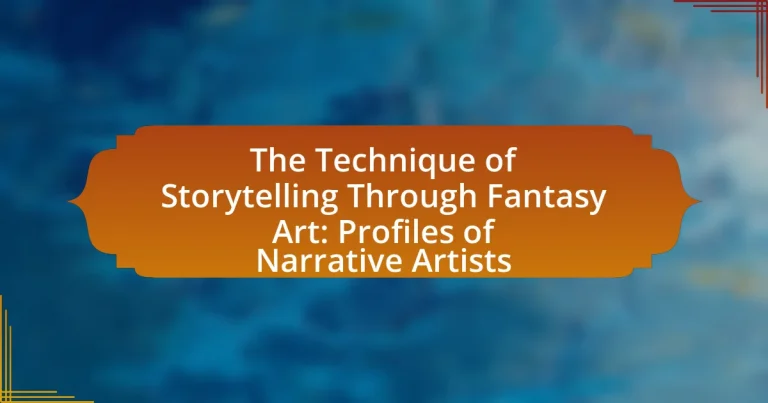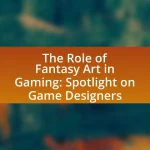The article focuses on the technique of storytelling through fantasy art, highlighting how visual elements such as composition, color, and character design convey narratives and emotions. It explores the impact of storytelling on viewer engagement, detailing common elements like character development, world-building, and symbolism that enhance narrative depth. The piece also examines the differences between visual narratives and traditional storytelling methods, the unique qualities of fantasy art, and the contributions of key narrative artists like Frank Frazetta and Brian Froud. Additionally, it discusses the psychological effects of color and composition, techniques for conveying character emotions, and resources for aspiring artists to develop their storytelling skills in this genre.
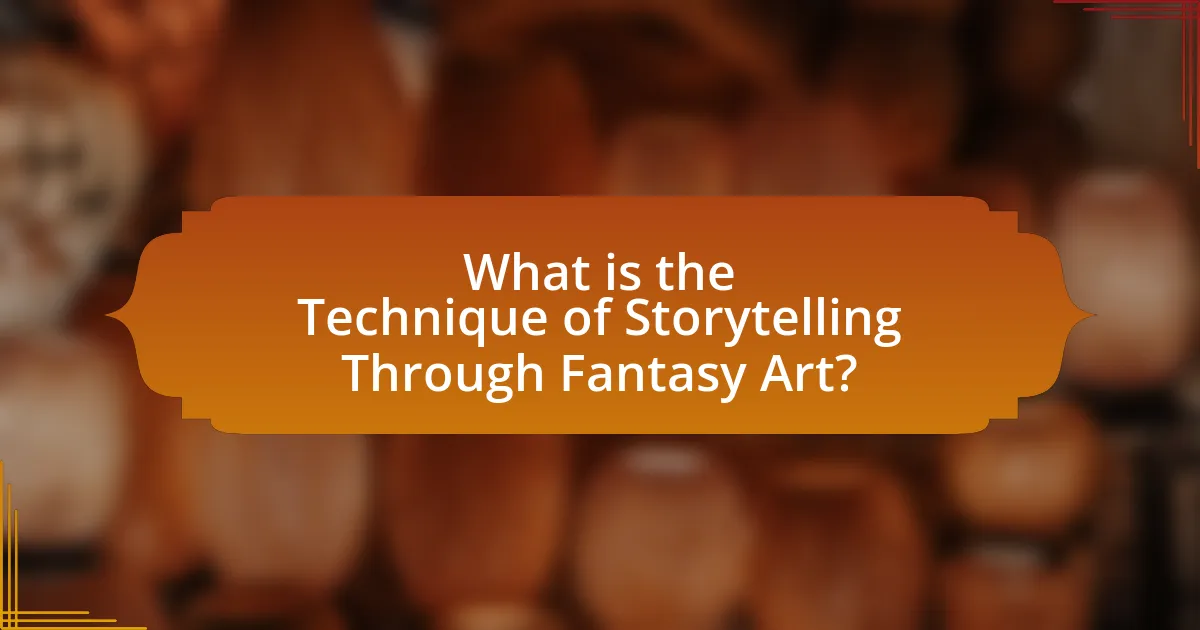
What is the Technique of Storytelling Through Fantasy Art?
The technique of storytelling through fantasy art involves using visual elements to convey narratives, emotions, and themes that resonate with viewers. Artists employ composition, color, and character design to create immersive worlds that invite interpretation and engagement. For instance, renowned fantasy artists like Frank Frazetta and Brian Froud utilize dynamic poses and intricate details to evoke a sense of action and wonder, effectively drawing the audience into their imagined realms. This method not only illustrates a story but also enhances the viewer’s emotional connection, making the artwork a powerful medium for narrative expression.
How does storytelling enhance the impact of fantasy art?
Storytelling enhances the impact of fantasy art by providing a narrative context that deepens viewer engagement and emotional resonance. When fantasy art incorporates storytelling elements, it allows the audience to connect with characters, settings, and themes on a personal level, fostering a sense of immersion. For instance, artworks that depict scenes from well-known fantasy narratives, such as J.R.R. Tolkien’s “The Lord of the Rings,” invite viewers to explore the rich lore and character arcs, making the visual experience more meaningful. This connection is supported by studies indicating that narratives can significantly increase memory retention and emotional response, thereby amplifying the overall impact of the artwork.
What elements of storytelling are commonly used in fantasy art?
Fantasy art commonly employs elements such as character development, world-building, conflict, and symbolism to convey narratives. Character development allows artists to create relatable figures that embody specific traits or journeys, enhancing viewer engagement. World-building establishes immersive settings that reflect the unique rules and cultures of the fantasy realm, drawing the audience into the story. Conflict introduces tension and challenges faced by characters, driving the narrative forward and creating emotional stakes. Symbolism enriches the artwork by embedding deeper meanings and themes, allowing for multiple interpretations. These elements work together to create a cohesive storytelling experience that resonates with viewers.
How do visual narratives differ from traditional storytelling methods?
Visual narratives differ from traditional storytelling methods primarily in their reliance on imagery to convey meaning rather than solely on text. While traditional storytelling often employs written or spoken language to develop characters and plot, visual narratives utilize illustrations, paintings, or digital art to evoke emotions and communicate themes. This method allows for immediate visual engagement, enabling audiences to interpret stories through visual cues, which can transcend language barriers. For instance, graphic novels and illustrated stories combine visual art with minimal text to create a more immersive experience, as seen in works like “Maus” by Art Spiegelman, where the imagery enhances the emotional depth of the narrative.
Why is fantasy art a powerful medium for storytelling?
Fantasy art is a powerful medium for storytelling because it visually encapsulates complex narratives and emotions, allowing viewers to engage with imaginative worlds. This genre of art employs vivid imagery, symbolism, and fantastical elements that can convey themes and character arcs in a single frame, making it accessible and evocative. For instance, artists like Frank Frazetta and Brian Froud have created iconic works that not only depict scenes but also evoke feelings of adventure, conflict, and wonder, effectively drawing audiences into the story. The visual nature of fantasy art transcends language barriers, enabling diverse interpretations and emotional connections, which enhances its storytelling potential.
What unique qualities does fantasy art bring to narrative expression?
Fantasy art uniquely enhances narrative expression by creating immersive worlds that transcend reality. This genre allows artists to visualize complex themes, emotions, and characters in ways that traditional art forms may not. For instance, fantasy art often employs vivid colors, imaginative creatures, and surreal landscapes, which can evoke strong emotional responses and stimulate the viewer’s imagination. Additionally, the use of symbolism in fantasy art can convey deeper meanings and narratives, allowing for multi-layered storytelling. This is evidenced by the works of artists like Frank Frazetta and Brian Froud, whose illustrations have become iconic for their ability to encapsulate entire stories within a single image, demonstrating the power of visual storytelling in the fantasy genre.
How does fantasy art engage the audience’s imagination?
Fantasy art engages the audience’s imagination by creating vivid, otherworldly scenes that invite viewers to explore new realms and narratives. This genre often employs rich colors, intricate details, and fantastical elements, which stimulate curiosity and emotional responses. For instance, artworks featuring mythical creatures or epic landscapes encourage viewers to envision stories and characters beyond their reality, fostering a sense of wonder. Research indicates that visual stimuli in fantasy art can activate the brain’s imagination centers, enhancing cognitive engagement and emotional investment in the depicted narratives.
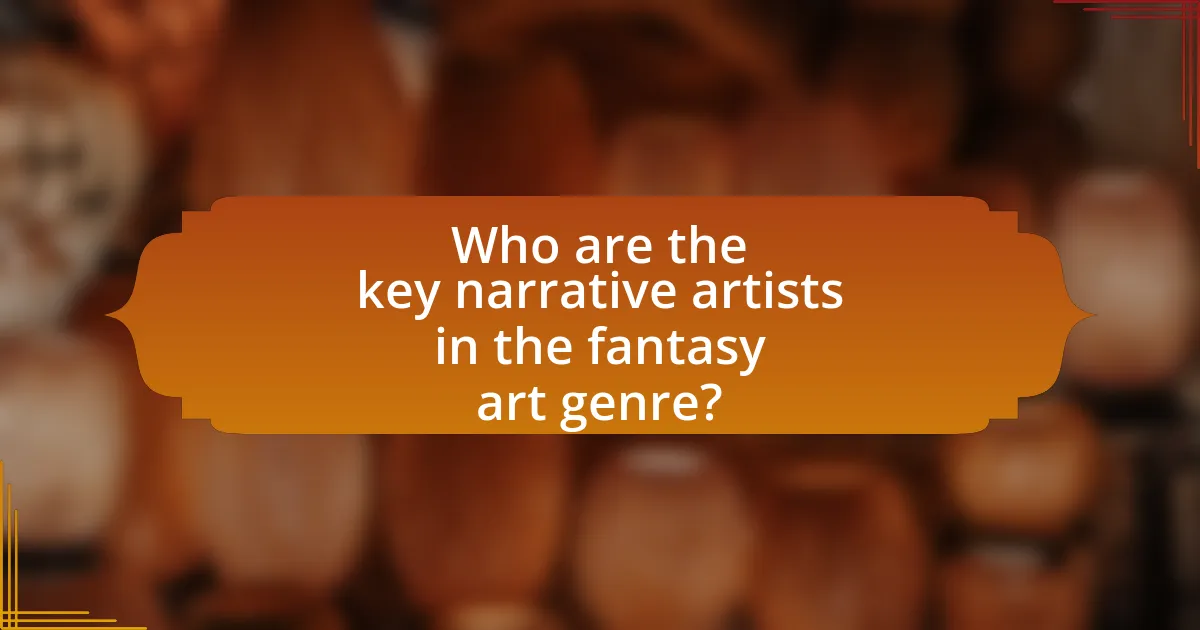
Who are the key narrative artists in the fantasy art genre?
Key narrative artists in the fantasy art genre include Frank Frazetta, Boris Vallejo, and Julie Bell. Frank Frazetta is renowned for his dynamic compositions and powerful figures, significantly influencing the visual language of fantasy art since the 1960s. Boris Vallejo is celebrated for his hyper-realistic depictions of fantasy characters, often featured in book covers and illustrations, which have become iconic in the genre. Julie Bell, known for her collaboration with Vallejo, combines traditional painting techniques with a modern sensibility, creating compelling narratives through her artwork. These artists have shaped the fantasy art landscape, establishing a visual storytelling tradition that resonates with audiences.
What are the defining characteristics of notable narrative artists?
Notable narrative artists are characterized by their ability to convey complex stories through visual imagery, often utilizing elements such as composition, color, and symbolism to enhance the narrative. These artists typically demonstrate a strong understanding of character development, allowing viewers to connect emotionally with the subjects depicted. Additionally, notable narrative artists often employ a unique style that reflects their personal vision while adhering to the conventions of storytelling, as seen in the works of artists like Frank Frazetta and Brian Froud, who effectively blend fantasy elements with compelling narratives. Their art often invites interpretation, encouraging viewers to engage with the story on multiple levels, which is a hallmark of effective narrative artistry.
How do their backgrounds influence their storytelling techniques?
Backgrounds significantly influence storytelling techniques by shaping the perspectives, themes, and styles that artists employ. For instance, an artist raised in a culturally rich environment may incorporate diverse mythologies and folklore into their narratives, enhancing the depth and relatability of their stories. Additionally, personal experiences, such as overcoming adversity or exploring identity, often inform the emotional resonance and character development within their works. Research indicates that artists’ unique life experiences can lead to distinct narrative choices, as seen in the works of artists like Hayao Miyazaki, whose childhood experiences in post-war Japan heavily influenced the themes of nature and resilience in his films.
What themes are prevalent in the works of these artists?
The prevalent themes in the works of narrative artists in fantasy art include the exploration of identity, the conflict between good and evil, and the journey of self-discovery. These themes are often depicted through fantastical elements and characters that symbolize deeper human experiences. For instance, many artists utilize mythical creatures and epic landscapes to represent internal struggles and moral dilemmas, reflecting the complexities of human nature. Additionally, the theme of transformation is frequently illustrated, showcasing characters who undergo significant changes, which serves as a metaphor for personal growth and resilience.
How do these artists utilize different mediums in their storytelling?
Artists utilize different mediums in their storytelling by employing techniques that enhance narrative depth and emotional engagement. For instance, visual artists may use oil paints for rich textures and vibrant colors, which evoke specific moods and atmospheres, while digital artists leverage software to create dynamic, interactive experiences that allow viewers to engage with the story in real-time. Additionally, sculptors might incorporate mixed media, combining materials like metal and glass to create tactile narratives that invite physical interaction. This multi-faceted approach enables artists to convey complex themes and emotions, as seen in the works of artists like Hayao Miyazaki, who blends animation with traditional storytelling to create immersive worlds.
What role does digital art play in modern fantasy storytelling?
Digital art serves as a crucial medium in modern fantasy storytelling by enhancing visual narratives and expanding creative possibilities. It allows artists to create immersive worlds and characters that engage audiences more deeply than traditional methods. For instance, digital art enables the manipulation of color, texture, and form, facilitating the portrayal of fantastical elements that are often impossible to achieve through conventional techniques. This capability is evidenced by the rise of digital platforms like ArtStation, where artists showcase their work, influencing the fantasy genre’s visual language and inspiring new narratives. Furthermore, digital art’s accessibility democratizes the creation process, allowing a diverse range of voices to contribute to fantasy storytelling, thereby enriching the genre as a whole.
How do traditional techniques compare to contemporary methods?
Traditional techniques in storytelling through fantasy art often emphasize manual craftsmanship, such as hand-drawing and painting, which allows for a unique, tactile quality and personal expression. In contrast, contemporary methods frequently utilize digital tools and software, enabling artists to experiment with a broader range of effects and streamline the creative process. For instance, traditional artists may rely on oil paints or watercolors, which require extensive skill and time, while contemporary artists can leverage programs like Adobe Photoshop or Procreate to create intricate designs more efficiently. This shift has led to a diversification of styles and accessibility in the art form, as digital platforms allow for easier sharing and collaboration among artists globally.
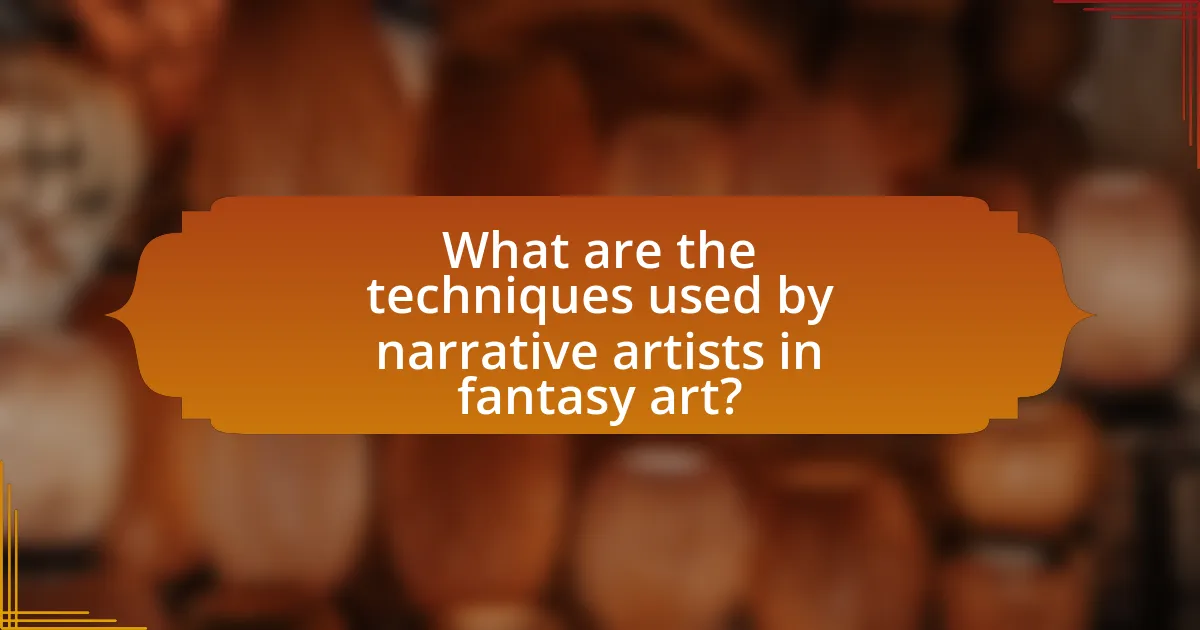
What are the techniques used by narrative artists in fantasy art?
Narrative artists in fantasy art employ techniques such as visual storytelling, character development, and world-building to convey complex narratives. Visual storytelling involves the use of composition, color, and perspective to guide the viewer’s eye and evoke emotions, while character development focuses on creating relatable and dynamic characters that drive the narrative forward. World-building is essential for establishing a believable and immersive setting, often incorporating intricate details that enhance the story’s context. These techniques are supported by historical practices in art, where artists like J.R.R. Tolkien and Frank Frazetta utilized similar methods to create compelling fantasy worlds that resonate with audiences.
How do color and composition contribute to storytelling in fantasy art?
Color and composition are essential elements that significantly enhance storytelling in fantasy art. Color sets the emotional tone and atmosphere, guiding the viewer’s feelings and reactions; for instance, warm colors like reds and oranges can evoke feelings of excitement or danger, while cool colors like blues and greens can create a sense of calm or mystery. Composition, on the other hand, organizes visual elements to direct the viewer’s attention and convey narrative flow; techniques such as the rule of thirds or leading lines can emphasize key characters or actions, thereby enhancing the story being told. Together, these elements create a cohesive visual narrative that engages the audience and deepens their understanding of the fantasy world depicted.
What psychological effects do color choices have on the viewer?
Color choices significantly influence the psychological responses of viewers, affecting emotions, perceptions, and behaviors. For instance, warm colors like red and orange can evoke feelings of warmth, excitement, or aggression, while cool colors such as blue and green often promote calmness and tranquility. Research by Andrew Elliot and Markus Maier in their study “Color and Psychological Functioning: A Review of Theoretical and Empirical Work” (2014) indicates that colors can also impact cognitive performance and decision-making processes. This demonstrates that color choices in art and design are not merely aesthetic but play a crucial role in shaping viewer experiences and interpretations.
How does composition guide the viewer’s eye through the narrative?
Composition guides the viewer’s eye through the narrative by strategically arranging elements within the artwork to create a visual flow. This flow directs attention to focal points, leading the viewer through the story being told. Techniques such as the rule of thirds, leading lines, and contrast are employed to emphasize key aspects of the narrative, ensuring that the viewer’s gaze follows a predetermined path. For instance, leading lines can draw the eye toward a central character or significant action, while contrasting colors can highlight important details, reinforcing the narrative’s emotional impact. These compositional strategies are essential in fantasy art, where complex scenes often require clear visual guidance to convey the intended story effectively.
What role does character design play in storytelling?
Character design plays a crucial role in storytelling by visually conveying a character’s personality, motivations, and emotional journey. Effective character design allows audiences to quickly understand a character’s traits and relationships within the narrative, enhancing engagement and empathy. For instance, distinct visual elements such as color schemes, shapes, and clothing can symbolize a character’s background or emotional state, as seen in animated films where heroes often have bright colors while villains may use darker palettes. This visual shorthand aids in storytelling by providing immediate context and depth, making the character’s journey more relatable and impactful.
How do character traits influence the narrative arc?
Character traits significantly influence the narrative arc by shaping characters’ decisions, motivations, and interactions, which drive the plot forward. For instance, a protagonist with strong leadership qualities may take decisive actions that lead to conflict resolution, while a character with selfish traits may create obstacles that complicate the storyline. This dynamic interaction between character traits and plot progression is evident in classic literature, such as in Shakespeare’s “Macbeth,” where Macbeth’s ambition leads to his downfall, illustrating how personal characteristics can dictate the trajectory of the narrative.
What techniques do artists use to convey character emotions?
Artists use techniques such as color theory, facial expressions, body language, and composition to convey character emotions. Color theory allows artists to evoke specific feelings; for example, warm colors like red can signify passion or anger, while cool colors like blue can represent sadness or calmness. Facial expressions are crucial, as they provide immediate visual cues about a character’s emotional state, with studies showing that viewers can interpret emotions through subtle changes in facial features. Body language further enhances emotional expression; for instance, slumped shoulders may indicate defeat, while an open stance can suggest confidence. Additionally, composition plays a significant role; the placement of characters within a scene can create tension or harmony, influencing how emotions are perceived. These techniques are supported by psychological research indicating that visual elements significantly impact emotional interpretation in art.
How can aspiring artists develop their storytelling skills through fantasy art?
Aspiring artists can develop their storytelling skills through fantasy art by creating detailed narratives within their artwork that engage viewers emotionally and intellectually. This involves constructing compelling characters, intricate settings, and dynamic plots that resonate with the audience. For instance, artists can study classic fantasy literature and analyze how authors build worlds and develop characters, which can inform their visual storytelling techniques. Additionally, participating in workshops or online courses focused on narrative art can provide practical skills and feedback from experienced artists. Research indicates that artists who actively engage in storytelling practices, such as sketching storyboards or writing character backstories, enhance their ability to convey complex narratives visually.
What resources are available for learning storytelling techniques in art?
Resources available for learning storytelling techniques in art include books, online courses, workshops, and academic programs. Notable books such as “The Art of Storytelling” by John D. Walsh and “Story: Substance, Structure, Style and the Principles of Screenwriting” by Robert McKee provide foundational knowledge. Online platforms like MasterClass and Coursera offer courses specifically focused on storytelling in visual arts. Additionally, workshops conducted by experienced narrative artists can provide hands-on experience and personalized feedback. Academic programs in fine arts or creative writing often include storytelling as a core component, equipping students with essential skills for narrative development in art.
How can practice and feedback improve narrative art skills?
Practice and feedback significantly enhance narrative art skills by allowing artists to refine their techniques and storytelling abilities. Regular practice enables artists to experiment with different styles, compositions, and narratives, leading to improved technical proficiency and creativity. Feedback from peers, mentors, or audiences provides critical insights into the effectiveness of the narrative elements, helping artists identify strengths and areas for improvement. Studies in art education indicate that iterative practice combined with constructive feedback accelerates skill development, as artists can adjust their approaches based on specific critiques, ultimately leading to more compelling and cohesive narratives in their artwork.
